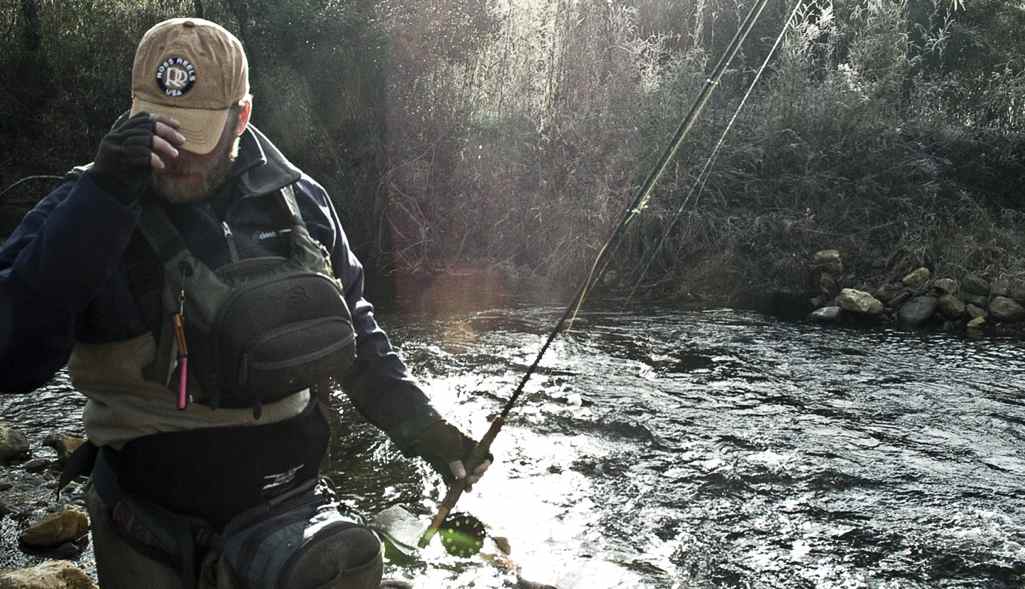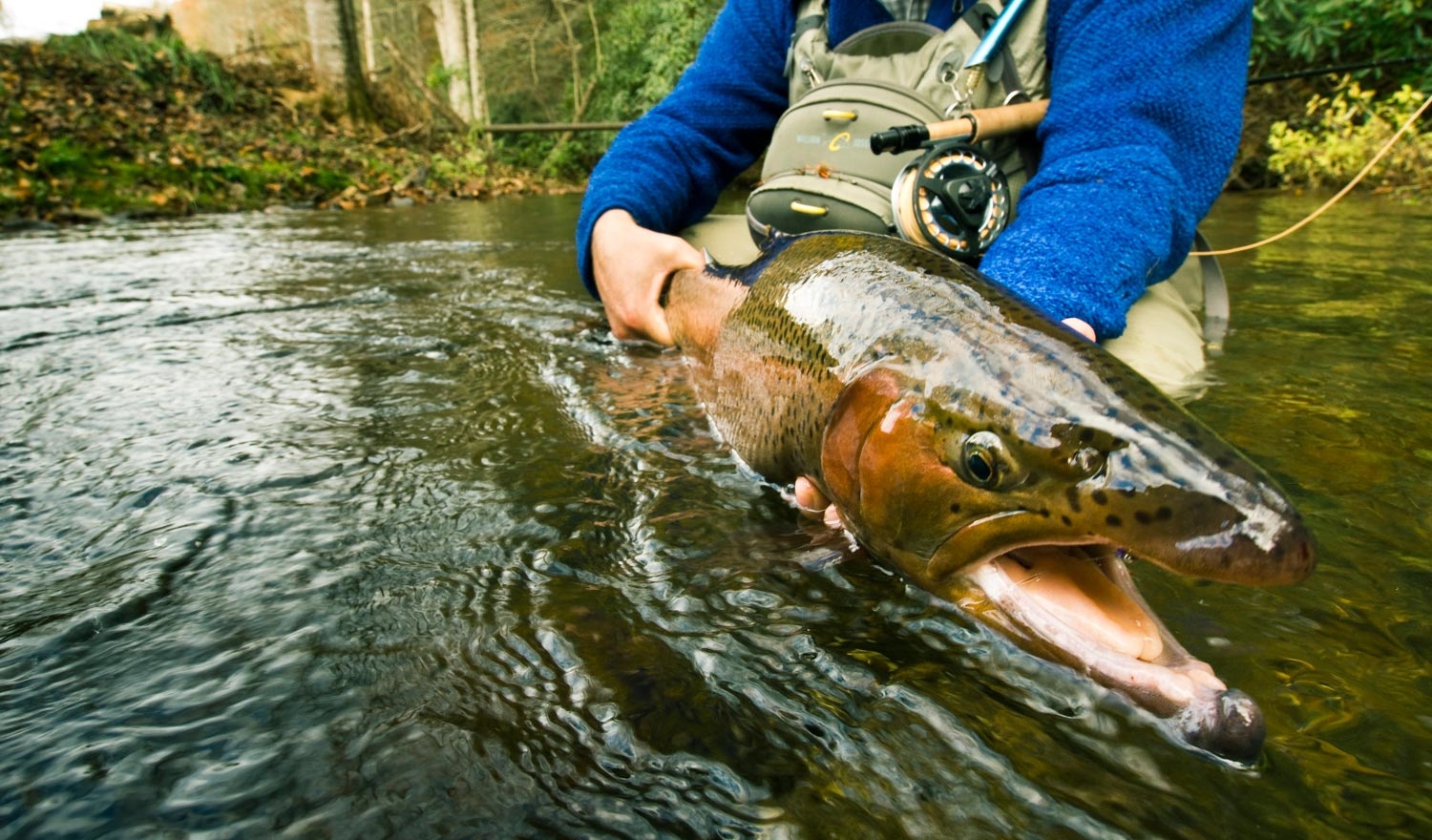Is there ever a time when an angler should admit defeat from a trout, pay his/her respects and move on?
We’ve all been there before, sight-fishing to a trophy trout, only to have it ignore our flies time and time again. An hour or more can go by without the slightest sign of interest by the fish, while it remains in the same basic holding spot all the while unafraid, almost as though it’s staring you down and challenging you to catch it. You press on with unwavering persistence until your patience runs dry. You’d argue that the trout isn’t hungry, and that’s why it hasn’t eaten any of the fly patterns, but every time you start to believe it as a viable excuse, you see the flash of white, from the trout opening its mouth and sucking in a bug. You’ve changed flies more than a dozen times now, you’ve made well over a hundred casts, and you’re ready to throw in the towel. Yet every time you reel in your line and begin to walk away, the feeling of defeat shouts “halt, go back! Just make a few more casts. You can do this.” Sometimes you end up winning the battle, other times the take never comes. The times when your line does come tight and you do hook and catch the trout, do you ever wonder if the fish really ate your fly or if you just accidentally flossed it?
I have a good friend from Colorado that told me he once scuba dived in a river and watched his buddy drift nymphs through runs that were loaded with trout. He said he was astonished to see how many times the tippet of the leader drifting in the current went into the mouths of trout, resulting in the fly of the hook snagging the trout. If you’ve ever fly fished for fresh sockeye salmon, you know that the majority of the time that’s exactly how you catch them. Only on rare occasions do they eat your fly, and even then one could argue it’s only out of aggression from the pending spawn. When my friend told me his underwater account, it made me wonder how many fish I thought I’d gotten to eat my fly in the past, but were actually fish that I really just flossed with my leader and snagged. Were those catches legitimate? Not unless you believe calculated or accidental flossing is legit. Maybe if you’re starving to death I could go along with that, but most of us don’t live off the land.
I guess what I’m trying to say is we shouldn’t always feel like we’ve lost as anglers if we can’t get a specific trout to eat our fly. I believe in changing out flies and giving his or her all, but I do think if you’re not a rookie, and you’ve caught plenty of fish in your life, you shouldn’t let the inner voice persuade you to keep at it until you end up snagging the fish. I’d much prefer to think that there’s some fish that are too smart to be caught, and if they very well are fish out there where that’s the case, we should respect them by knowing when to reel in our line and walk away. After all, if we caught every trout that we fished to, would it really be all that rewarding or entertaining? The answer is no. If that were the case, we’d probably be wading trout stream trying to catch them with our bare hands instead of using fly rods and hand tied flies.
I’ll never know with 100% certainty if this magnificent trout legitimately ate my fly or not. I hooked him below a waterfall in the middle of a fast water shoot, after about fifty consecutive blind drifts. With the size of his mouth, I have a bad feeling that I may have accidentally flossed the poor guy. Although I’m not proud of the possible accidental flossing, I am proud of landing this beast. When I set the hook on him, he shot out of the water like he had a rocket strapped to his back. Four additional jumps and two strong runs later, Louis netted him for me.
That’s my fly fishing rambles for today. What’s your thoughts on the subject of whether or not there’s a time when an angler should admit defeat from a fish and walk away?
Keep it Reel,
Kent Klewein Gink & Gasoline www.ginkandgasoline.com hookups@ginkandgasoline.com Sign Up For Our Weekly Newsletter!


Most “flossed” fish are hooked on the outside of the mouth, eaten flies on the inside. Exceptions exist, like for streamers and pegged eggs where oitside hookage commonly occurs.
A guide once told me that if you are in moving water and you’re not catching fish, change something, e.g. your fly, depth, or location. After casting at fish repeatedly, sometimes they go stiff and stop feeding for a while. It all depends on how spooky they are.
Flossing is a perfectly legitmate way to catch fish in my opinion. I don’t ever intentionally do it on fish that are supposed to be feeding (e.g. stream dwelling trout), but I go to the Salmon River in Pulaski every year and I have done it to Steelhead from Lake Erie too. If those fish aren’t eat, who really cares how I hook up with them? They aren’t natural either, so again, who cares. And to anyone that says it’s easy to floss fish, you’re wrong. It’s easy to snag fish. Flossing can be pretty hard. Just my thoughts
Flossing, lining, and snagging have been the ‘go-to’ methods for Salmon River guides and regulars for decades. They are NOT legitimate fishing methods when done purposefully. Catching a steel head in your bare hands is really hard too, but that doesn’t make it a legitimate angling method.
The intentional flossing or lining of steelhead diminishes the accomplishment and makes those hero shots a bit unsavory.
For those naïve enough to think that a steelhead is really trying to eat your small dark nymph, my apologies for breaking your bubble.
If I had a choice between being skunked and flossing/foul hooking a fish, I’ll take the skunk anytime. I think we all follow the well-hashed paradigm of desiring lots-of-fish, then big-fish, to smart-fish, and finally to just going fishing. For years I had to catch fish to feel like I was worth it or competent. As time went on I became more secure with my abilities, less worried about what the dude downstream was catching, and less focused on body counts. If I can’t trick a trout into trying to eat the fur and feathers I have lashed onto a hook, then I don’t deserve to catch him. And I’m ok with that.
In regards to the comment above, I respectfully, yet emphatically disagree with that approach. Flossing deliberately is no different than snagging. I live midway between the Salmon River and the Delaware system, and I will not fish the SR, mainly due to this kind of attitude being prevalent.
— He said he was astonished to see how many times the tippet of the leader drifting in the current went into the mouths of trout, resulting in the fly of the hook snagging the trout.
I have to call BS on this. If you have watched resting trout underwater (not fish just played and released) then you know they swim with their mouths closed. This so called ‘flossing’ is very rare indeed on trout. More common on salmon with their hooked jaw. Now outright snagging is fairly common but the hook is not in the mouth.
This information casts a pall over the use of nymphs for trout. Especially Euro-style (Czech) nymphing. My guess is that more than half the hook ups are a result of flossing or lining. Just another reason I fish dry flies exclusively. In the words of Lee Wulff, “trout deserve the sanctuary of deep water.”
That’s an interesting assumption, but as someone who primarily uses nymphs and streamers, I can say that it’s a ridiculous claim. It’s a very rare occurrence for me to see a trout hooked anywhere besides the inside of it’s mouth unless it got snagged on a dropper while turning away from the top fly. Using dries only doesn’t mean you’re more skilled of an angler. It simply means you are fine with limiting yourself and your catch rate.
What? Euro-style is done on a tight line and a down-stream bow in the water column. You’re not flossing with that technique. For reds, they put a bead or streamer 2 feet down from split-shot and floss on the swing…and I’m sure that when his CO buddy was watching, it was with an inline rig as well.
There’s a reason these guys “vacuum” the stream.
I just returned from a trip to a southern tail water loaded with large browns. I fished exclusively at night chucking streamers. I’d scout a section of river the night before fishing it. I knew there were hundreds of large trout and certain spots that held many of them. The first night I hit those cherry spots hard and come away empty handed. I started making a couple nice swings through a hole and move on. If there was a player in that hole they would hit the first or second swing. Bouncing meat off their noggins 50 times in a row was a waste of time.
It was hard to walk away from some of the biggest fish I have ever seen, but it worked out.
Dear Moderator, I recently commented on this article, explaining that it seemed to be in error because trout normally swim with their mouth closed. Please have the courtesy of informing me why you did not post my comment. That way I might better understand and avoid wasting my time writing up a thoughtful comment.
Sincerely, Mark DeHaan
Sorry that took a minute dude. I was on the river. It come with the job!
Hey Mark trout have to open their mouths for respiration, or they die. It’s part of gas exchange: water in the mouth, over the gils, and out. Basic fish physiology.
I have watched some video of trout underwater and they were opening and closing their mouths a lot. What was interesting was the amount of stuff that was not food that they sucked in and spit out.